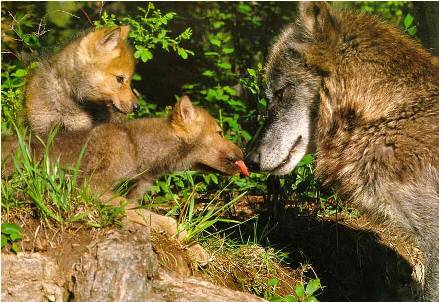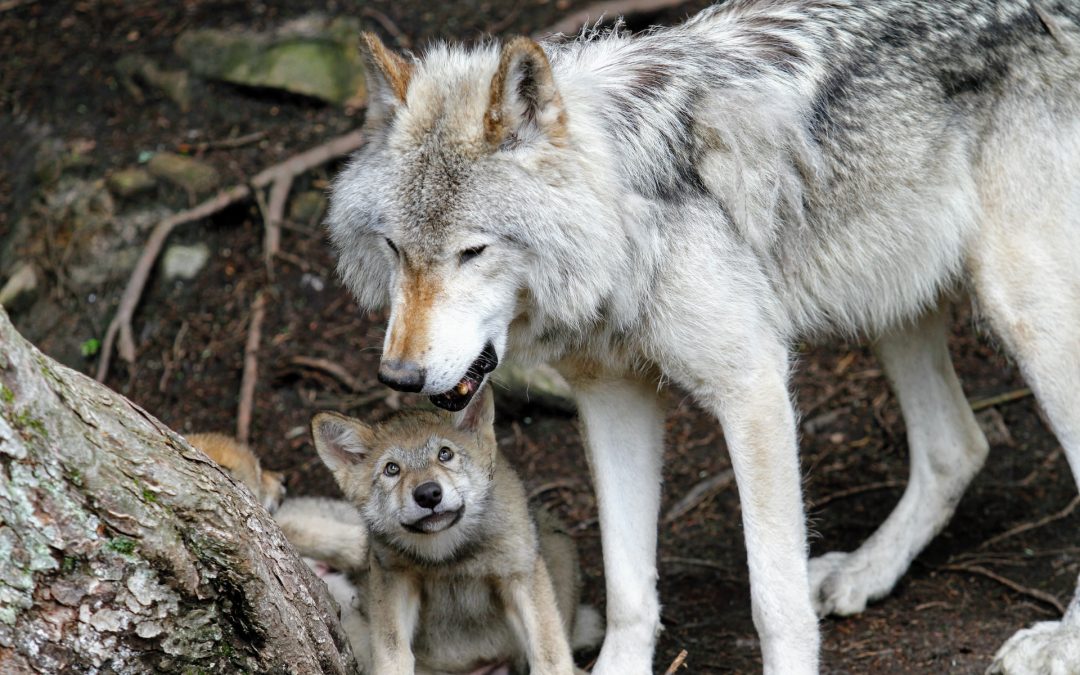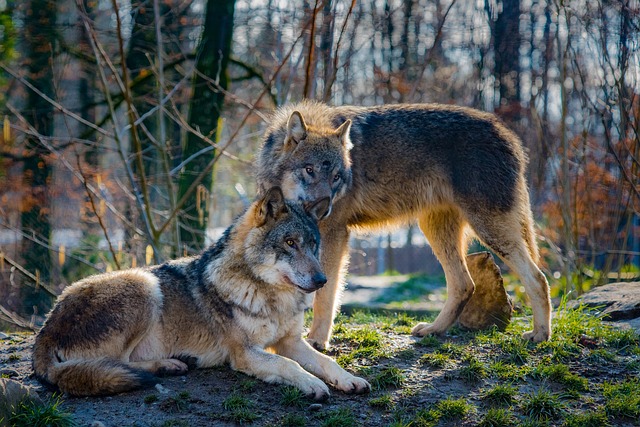
by Deep Green Resistance News Service | Aug 10, 2012 | Biodiversity & Habitat Destruction
By Russ McSpadden / Earth First! Journal
The U.S. Fish and Wildlife service has ordered the killing of an alpha female Mexican gray wolf for crimes against the cattle industry. She is accused of being the ringleader of a six member pack that has killed four cows in southwestern New Mexico over the last several months.
Extirpated from the wild by the 1950s, reintroduced through captive breeding programs in 1998, Mexican gray wolves are far from recovered. The outlaw matriarch of the Fox Mountain Pack—last seen roaming the mountainous woodlands of the northwest portion of the Gila National Forest—is one of only 58 of her kind left in the U.S. Southwest. And though Mexican gray wolves are endangered and federally protected she is now on the federal government’s hit list. There’s no telling how long she and her pups can hold out under the cover of pinion and ponderosa pine or the conifers of the colder peaks of the range with a warrant out for her life.
The ranchers who suffered the loss of cattle have already been reimbursed.
In 2007, the Fish and Wildlife service ordered the shooting of an alpha female of the Durango Pack in the Gila, also for cattle depredation. In a tragic twist of timing, then-governor of New Mexico, Bill Richardson recalled the state’s order but his message arrived too late. She was killed in June of that year. Her lover and their pups disappeared and have not been spotted since. They are presumed dead.
Will the Fox Mountain Matriarch outwit the cattle lobbyists and government assassins long enough for an injunction?
From Earth First! Newswire: http://earthfirstnews.wordpress.com/2012/08/09/outlaw-matriarch-of-the-fox-mountain-pack-ordered-dead-by-feds/

by Deep Green Resistance News Service | Jun 20, 2012 | Biodiversity & Habitat Destruction
By The Wilderness Society
Today the U.S. House of Representatives passed a package of anti-wilderness bills (H.R. 2578), including H.R. 1505, the “National Security and Federal Lands Protection Act.”
H.R. 1505 would hand over “operational control” of federal public lands within 100 miles of the Canadian and Mexican borders to the U.S. border patrol, and could open national parks, wildlife refuges, wilderness and other public lands to development, such as construction and road building. Rep. Raul Grijalva’s (D, AZ-7) amendment to strike H.R. 1505 from the package was unfortunately defeated. This package of bills now awaits movement in the Senate.
Prior to the House vote, a coalition of Hispanic and immigration reform advocates, Native American tribal organizations, sportsmen, businesses and conservation groups, sent a letter to members of Congress voicing their opposition and asking members to vote against the bill.
“H.R. 1505 is an overreach that would adversely affect everyone who enjoys America’s public lands,” said David Moulton, senior legislative director at The Wilderness Society. “The bill would allow road building, construction and development on lands that are loved for hunting, fishing, hiking and other recreational activities. This vote was not in the best interest of the people who enjoy the land for its natural beauty.”
H.R. 1505 is part of an anti-wilderness package that includes, among other destructive bills:
• The Sealaska bill would give away tens of thousands of acres of high-value public land from the Tongass National Forest to the Sealaska Corporation. This would allow the corporation to clear-cut valuable forest land and take ownership of the best recreation sites at the heads of bays or mouths of salmon streams. This land giveaway would effectively prevent a long-planned transition out of old growth logging on the national forest, and privatize prime recreation spots that are currently open to the American public for fishing, hunting, and recreation and are relied upon by many small tourism, outfitter and fisheries businesses.
• Title XI, the “Grazing Improvement Act,” is a virtual giveaway of over 247 million acres of Bureau of Land Management (BLM) and National Forest rangelands to the approximately 27,000 livestock producers who have grazing privileges on the lands managed by these two agencies. The bill would change the term of federal livestock grazing leases from the current ten years to 20 years. No other government entity in the U.S. issues 20-year livestock grazing permits. In addition, Title XI reduces the level of environmental scrutiny of livestock grazing practices on BLM and National Forest lands by allowing these agencies to exempt the issuance of grazing permits from National Environmental Policy Act review.
• The Quincy Library Group bill would take an unsuccessful and outmoded forest management pilot program and expand it across much of northern California, while simultaneously authorizing logging in roadless areas, spotted owl habitat, salmon habitat and other areas of critical environmental importance and mandating minimum annual timber cuts.
Opposed by the Department of Homeland Security (DHS), H.R. 1505 could endanger personal freedoms by closing without notice our lands to hunting, fishing, tourism and recreation, all multi-million dollar industries that support small businesses. DHS Secretary Napolitano testified before Congress in opposition to H.R. 1505, saying it “is unnecessary, and it’s bad policy.” DHS benefits from their close collaboration with law enforcement counterparts in the land management agencies. In addition to threatening lands, the bill threatens this collaboration.
H.R. 1505 is an extreme and radical measure that would put at risk 49 million acres of public lands in 17 states, sweeping away 16 bedrock environmental and land management laws in Joshua Tree National Park, Boundary Waters Canoe Area Wilderness, Acadia National Park and any other protected land that sits within 100 miles of the border.
The Wilderness Society recently updated the report, “Wilderness Under Siege,” to reflect the movement of these and other bills and what they would mean to America’s lands, waters and natural legacy. Also mentioned in the report is H.R. 4089 — a Trojan horse bill that includes a sneak attack on wilderness. H.R. 4089 recently passed the House, and awaits passage in the Senate.
From The Wilderness Society: http://wilderness.org/content/land-grab-masked-national-security-measure-passes-us-house-representatives
Photo by CDC on Unsplash
by Deep Green Resistance News Service | Apr 30, 2012 | Agriculture, Biodiversity & Habitat Destruction
By Tom Knudson / The Sacramento Bee
The day began with a drive across the desert, checking the snares he had placed in the sagebrush to catch coyotes.
Gary Strader, an employee of the U.S. Department of Agriculture, stepped out of his truck near a ravine in Nevada and found something he hadn’t intended to kill.
There, strangled in a neck snare, was one of the most majestic birds in America, a federally protected golden eagle.
“I called my supervisor and said, ‘I just caught a golden eagle and it’s dead,’ ” said Strader. “He said, ‘Did anybody see it?’ I said, ‘Geez, I don’t think so.’
“He said, ‘If you think nobody saw it, go get a shovel and bury it and don’t say nothing to anybody.’ ”
“That bothered me,” said Strader, whose job was terminated in 2009. “It wasn’t right.”
Strader’s employer, a branch of the federal Department of Agriculture called Wildlife Services, has long specialized in killing animals that are deemed a threat to agriculture, the public and – more recently – the environment.
Since 2000, its employees have killed nearly a million coyotes, mostly in the West. They have destroyed millions of birds, from nonnative starlings to migratory shorebirds, along with a colorful menagerie of more than 300 other species, including black bears, beavers, porcupines, river otters, mountain lions and wolves.
And in most cases, they have officially revealed little or no detail about where the creatures were killed, or why. But a Bee investigation has found the agency’s practices to be indiscriminate, at odds with science, inhumane and sometimes illegal.
The Bee’s findings include:
• With steel traps, wire snares and poison, agency employees have accidentally killed more than 50,000 animals since 2000 that were not problems, including federally protected golden and bald eagles; more than 1,100 dogs, including family pets; and several species considered rare or imperiled by wildlife biologists.
• Since 1987, at least 18 employees and several members of the public have been exposed to cyanide when they triggered spring-loaded cartridges laced with poison meant to kill coyotes. They survived – but 10 people have died and many others have been injured in crashes during agency aerial gunning operations over the same time period.
• A growing body of science has found the agency’s war against predators, waged to protect livestock and big game, is altering ecosystems in ways that diminish biodiversity, degrade habitat and invite disease.
Sometimes wild animals must be destroyed – from bears that ransack mountain cabins to geese swirling over an airport runway. But because lethal control stirs strong emotions, Wildlife Services prefers to operate in the shadows.
“We pride ourselves on our ability to go in and get the job done quietly without many people knowing about it,” said Dennis Orthmeyer, acting state director of Wildlife Services in California.
Basic facts are tightly guarded. “This information is Not intended for indiscriminate distribution!!!” wrote one Wildlife Services manager in an email to a municipal worker in Elk Grove about the number of beavers killed there.
And while even the military allows the media into the field, Wildlife Services does not. “If we accommodated your request, we would have to accommodate all requests,” wrote Mark Jensen, director of Wildlife Services in Nevada, turning down a request by The Bee to observe its hunters and trappers in action.
“The public has every right to scrutinize what’s going on,” said Carter Niemeyer, a former Wildlife Services district manager who worked for the agency for 26 years and now believes much of the bloodletting is excessive, scientifically unsound and a waste of tax dollars.
“If you read the brochures, go on their website, they play down the lethal control, which they are heavily involved in, and show you this benign side,” Niemeyer said. “It’s smoke and mirrors. It’s a killing business. And it ain’t pretty.
“If the public knows this and they don’t care, I’m not going to lose any sleep over it,” Niemeyer said. “But they are entitled to know.”
Agency officials say the criticism is misleading. “If we can use nonlethal control first, we usually do it,” said William Clay, deputy administrator of Wildlife Services. “The problem is, generally when we get a call, it’s because farmers and ranchers are having livestock killed immediately. They are being killed daily. Our first response is to try to stop the killing and then implement nonlethal methods.”
In March, two congressmen – Reps. John Campbell, R-Irvine, and Peter DeFazio, D-Ore. – introduced a bill that would ban one of Wildlife Services’ most controversial killing tools: spring-loaded sodium cyanide cartridges that have killed tens of thousands of animals in recent years, along with Compound 1080 (thallium sulfate), a less-commonly used poison.
“This is an ineffective, wasteful program that is largely unaccountable, lacks transparency and continues to rely on cruel and indiscriminate methods,” said Camilla Fox, executive director of Project Coyote, a Bay Area nonprofit.
“If people knew how many animals are being killed at taxpayer expense – often on public lands – they would be shocked and horrified,” Fox said.

by Deep Green Resistance News Service | Apr 10, 2012 | Biodiversity & Habitat Destruction, NEWS
By Oregon State University
A survey on the loss in the Northern Hemisphere of large predators, particularly wolves, concludes that current populations of moose, deer, and other large herbivores far exceed their historic levels and are contributing to disrupted ecosystems.
The research, published today by scientists from Oregon State University, examined 42 studies done over the past 50 years.
It found that the loss of major predators in forest ecosystems has allowed game animal populations to greatly increase, crippling the growth of young trees and reducing biodiversity. This also contributes to deforestation and results in less carbon sequestration, a potential concern with climate change.
“These issues do not just affect the United States and a few national parks,” said William Ripple, an OSU professor of forestry and lead author of the study. “The data from Canada, Alaska, the Yukon, Northern Europe and Asia are all showing similar results. There’s consistent evidence that large predators help keep populations of large herbivores in check, with positive effects on ecosystem health.”
Densities of large mammalian herbivores were six times greater in areas without wolves, compared to those in which wolves were present, the researchers concluded. They also found that combinations of predators, such as wolves and bears, can create an important synergy for moderating the size of large herbivore populations.
“Wolves can provide food that bears scavenge, helping to maintain a healthy bear population,” said Robert Beschta, a professor emeritus at OSU and co-author of the study. “The bears then often prey on young moose, deer or elk – in Yellowstone more young elk calves are killed by bears than by wolves, coyotes and cougars combined.”
In Europe, the coexistence of wolves with lynx also resulted in lower deer densities than when wolves existed alone.
In recent years, OSU researchers have helped lead efforts to understand how major predators help to reduce herbivore population levels, improve ecosystem function and even change how herbivores behave when they feel threatened by predation – an important aspect they call the “ecology of fear.”
“In systems where large predators remain, they appear to have a major role in sustaining the diversity and productivity of native plant communities, thus maintaining healthy ecosystems,” said Beschta. “When the role of major predators is more fully appreciated, it may allow managers to reconsider some of their assumptions about the management of wildlife.”
In Idaho and Montana, hundreds of wolves are now being killed in an attempt to reduce ranching conflicts and increase game herd levels.
The new analysis makes clear that the potential beneficial ecosystem effects of large predators is far more pervasive, over much larger areas, than has often been appreciated.
It points out how large predators can help maintain native plant communities by keeping large herbivore densities in check, allow small trees to survive and grow, reduce stream bank erosion, and contribute to the health of forests, streams, fisheries and other wildlife.
It also concludes that human hunting, due to its limited duration and impact, is not effective in preventing hyper-abundant densities of large herbivores. This is partly “because hunting by humans is often not functionally equivalent to predation by large, wide-ranging carnivores such as wolves,” the researchers wrote in their report.
“More studies are necessary to understand how many wolves are needed in managed ecosystems,” Ripple said. “It is likely that wolves need to be maintained at sufficient densities before we see their resulting effects on ecosystems.”
The research was published online today in the European Journal of Wildlife Research, a professional journal.
“The preservation or recovery of large predators may represent an important conservation need for helping to maintain the resiliency of northern forest ecosystems,” the researchers concluded, “especially in the face of a rapidly changing climate.”
From Oregon State University Relations and Marketing: http://oregonstate.edu/ua/ncs/archives/2012/apr/loss-predators-northern-hemisphere-affecting-ecosystem-health
Photo by M L on Unsplash

by Deep Green Resistance News Service | Feb 28, 2012 | Biodiversity & Habitat Destruction, NEWS
By Jeremy Hance, Mongabay
Less than a year after being pulled off the Endangered Species Act (ESA), gray wolves (Canis lupus) in the western U.S. are facing an onslaught of hunting. The hunting season for wolves has just closed in Montana with 160 individuals killed, around 75 percent of 220-wolf kill quota for the state. In neighboring Idaho, where 318 wolves have been killed so far by hunters and trappers, the season extends until June. In other states—Oregon, Washington, California, and Utah—wolf hunting is not currently allowed, and the species is still under federal protection in Wyoming.
In Idaho fourteen wolves were also killed by the government using helicopters in a bid to prop up elk herds. Legislators in the state are also mulling a recent proposal to allow aerial hunting and the use of live bait to kill wolves that have harassed livestock or pets. Republican and sheep rancher Jeff Siddoway, who introduced the legislation, said he would have no problem using his dog as live bait.
Wolves are hugely controversial in the region: ranchers point to them as a cause for livestock mortalities, while hunters blame them for a decline in elk. Biologists, however, say the elk decline may be due to a combination of drought, hunting by people, and the return of wolves. By nature wolves prey on young, old, and weak animals, and likely have little overall impact on a healthy herd.
In fact, a recent study study in Montana’s Bitterroot Mountains found that wolves were not a primary driver behind elk mortalities. Examining 36 elk calf kills, the study determined that mountain lions were responsible for thirteen (36 percent), black bears killed four (11 percent), wolves also killed four (11 percent), five died of natural causes (13 percent), and ten mortalities were due to unknown causes (27 percent).
However, as top predators, wolves have a big impact on elk and other prey’s behavior, which results in massive implications for the health of an ecosystem. Long-term studies in Yellowstone National Park have recorded notable changes since the return of wolves after a 70-year absence. The findings have shown that wolves are key to a healthy, diverse ecosystem.
Research has found that by keeping elk on the run and in hiding, wolves protect plants and trees that had long been over-browsed, saving some species from local extinction. The presence of wolves allowed trees to grow up along rivers for the first time in decades in Yellostone, protecting against erosion and cooling rivers through shade. In turn, the riverside trees allowed for the return of beavers, which had nearly vanished from Yellowstone. Through dam-building beavers created new habitat for fish. With more trees and shrub cover, songbird populations rose. Scavengers from bear to ravens were aided by wolf-kills. In all, biodiversity and wildlife abundance blossomed.
Less than 2,000 wolves are currently found in seven states of the western U.S., the bulk of them in Montana, Idaho, and Wyoming. California has only one. By contrast 3,000 wolves are found in northern Minnesota alone.




